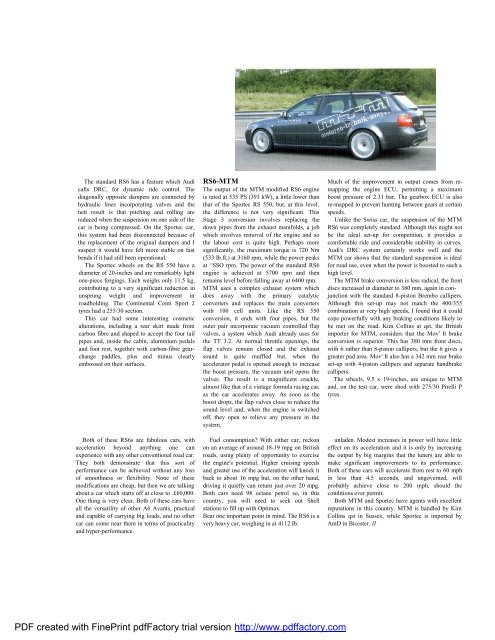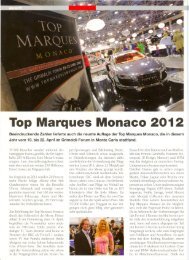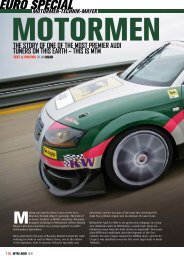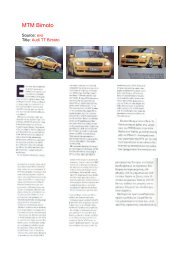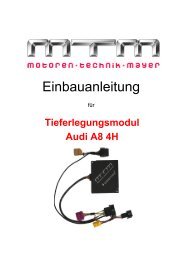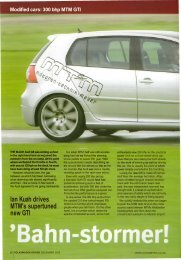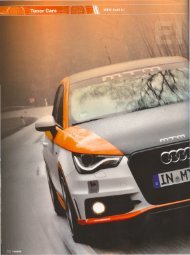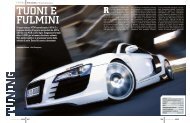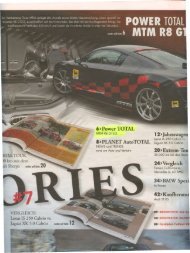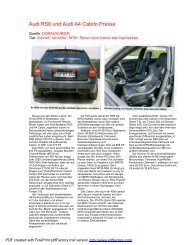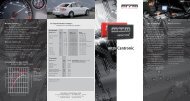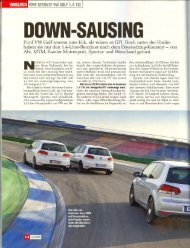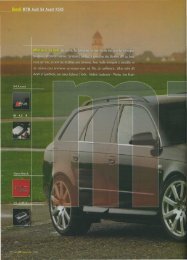Audi RS6 - MTM
Audi RS6 - MTM
Audi RS6 - MTM
You also want an ePaper? Increase the reach of your titles
YUMPU automatically turns print PDFs into web optimized ePapers that Google loves.
The standard <strong>RS6</strong> has a feature which <strong>Audi</strong><br />
calls DRC, for dynamic ride control. The<br />
diagonally opposite dampers are connected by<br />
hydraulic lines incorporating valves and the<br />
nett result is that pitching and rolling are<br />
reduced when the suspension on one side of the<br />
car is being compressed. On the Sportec car,<br />
this system had been disconnected because of<br />
the replacement of the original dampers and I<br />
suspect it would have felt more stable on fast<br />
bends if it had still been operational.<br />
The Sportec wheels on the RS 550 have a<br />
diameter of 20-inches and are remarkably light<br />
one-piece forgings. Each weighs only 11.5 kg,<br />
contributing to a very significant reduction in<br />
unsprung weight and improvement in<br />
roadholding. The Continental Conti Sport 2<br />
tyres had a 255/30 section.<br />
This car had some interesting cosmetic<br />
alterations, including a rear skirt made from<br />
carbon fibre and shaped to accept the four tail<br />
pipes and, inside the cabin, aluminium pedals<br />
and foot rest, together with carbon-fibre gearchange<br />
paddles, plus and minus clearly<br />
embossed on their surfaces.<br />
Both of these <strong>RS6</strong>s are fabulous cars, with<br />
acceleration beyond anything one can<br />
experience with any other conventional road car.<br />
They both demonstrate that this sort of<br />
performance can be achieved without any loss<br />
of smoothness or flexibility. None of these<br />
modifications are cheap, but then we are talking<br />
about a car which starts off at close to .£60,000.<br />
One thing is very clear. Both of these cars have<br />
all the versatility of other A6 Avants, practical<br />
and capable of carrying big loads, and no other<br />
car can come near them in terms of practicality<br />
and hyper-performance.<br />
<strong>RS6</strong>-<strong>MTM</strong><br />
The output of the <strong>MTM</strong> modified <strong>RS6</strong> engine<br />
is rated at 535 PS (393 kW), a little lower than<br />
that of the Sportec RS 550, but, at this level,<br />
the difference is not very significant. This<br />
Stage 3 conversion involves replacing the<br />
down pipes from the exhaust manifolds, a job<br />
which involves removal of the engine and so<br />
the labour cost is quite high. Perhaps more<br />
significantly, the maximum torque is 720 Nm<br />
(533 Ib.ft.) at 3160 rpm, while the power peaks<br />
at ^SSO rpm. The power of the standard <strong>RS6</strong><br />
engine is achieved at 5700 rpm and then<br />
remains level before falling away at 6400 rpm.<br />
<strong>MTM</strong> uses a complex exhaust system which<br />
does away with the primary catalytic<br />
converters and replaces the main converters<br />
with 100 cell units. Like the RS 550<br />
conversion, it ends with four pipes, but the<br />
outer pair incorporate vacuum controlled flap<br />
valves, a system which <strong>Audi</strong> already uses for<br />
the TT 3.2. At normal throttle openings, the<br />
flap valves remain closed and the exhaust<br />
sound is quite muffled but, when the<br />
accelerator pedal is opened enough to increase<br />
the boost pressure, the vacuum unit opens the<br />
valves. The result is a magnificent crackle,<br />
almost like that of a vintage formula racing car,<br />
as the car accelerates away. As soon as the<br />
boost drops, the flap valves close to reduce the<br />
sound level and, when the engine is switched<br />
off, they open to relieve any pressure in the<br />
system.<br />
Fuel consumption? With either car, reckon<br />
on an average of around 18-19 mpg on British<br />
roads, using plenty of opportunity to exercise<br />
the engine's potential. Higher cruising speeds<br />
and greater use of the acceleration will knock it<br />
back to about 16 mpg hut, on the other hand,<br />
driving it quietly can return just over 20 mpg.<br />
Both cars need 98 octane petrol so, in this<br />
country, you will need to seek out Shell<br />
stations to fill up with Optimax.<br />
Bear one important point in mind. The <strong>RS6</strong> is a<br />
very heavy car, weighing in at 4112 Ib.<br />
PDF created with FinePrint pdfFactory trial version http://www.pdffactory.com<br />
Much of the improvement in output comes from remapping<br />
the engine ECU, permitting a maximum<br />
boost pressure of 2.31 bar. The gearbox ECU is also<br />
re-mapped to prevent hunting between gears at certain<br />
speeds.<br />
Unlike the Swiss car, the suspension of the <strong>MTM</strong><br />
<strong>RS6</strong> was completely standard. Although this might not<br />
be the ideal set-up for competition, it provides a<br />
comfortable ride and considerable stability in curves.<br />
<strong>Audi</strong>'s DRC system certainly works well and the<br />
<strong>MTM</strong> car shows that the standard suspension is ideal<br />
for road use, even when the power is boosted to such a<br />
high level.<br />
The <strong>MTM</strong> brake conversion is less radical, the front<br />
discs increased in diameter to 380 mm, again in con-<br />
junction with the standard 8-piston Brembo callipers.<br />
Although this set-up may not match the 400/355<br />
combination at very high speeds, I found that it could<br />
cope powerfully with any braking conditions likely to<br />
be met on the road. Kim Collins at qst, the British<br />
importer for <strong>MTM</strong>, considers that the Mov' It brake<br />
conversion is superior. This has 380 mm front discs,<br />
with 6 rather than 8-piston callipers, but the 6 gives a<br />
greater pad area. Mov' It also has a 342 mm rear brake<br />
set-up with 4-piston callipers and separate handbrake<br />
callipers.<br />
The wheels, 9.5 x 19-inches, are unique to <strong>MTM</strong><br />
and, on the test car, were shod with 275/30 Pirelli P<br />
tyres.<br />
unladen. Modest increases in power will have little<br />
effect on its acceleration and it is only by increasing<br />
the output by big margins that the tuners are able to<br />
make significant improvements to its performance.<br />
Both of these cars will accelerate from rest to 60 mph<br />
in less than 4.5 seconds, and ungoverned, will<br />
probably achieve close to 200 mph, should the<br />
conditions ever permit.<br />
Both <strong>MTM</strong> and Sportec have agents with excellent<br />
reputations in this country. <strong>MTM</strong> is handled by Kim<br />
Collins qst in Sussex, while Sportec is imported by<br />
AmD in Bicester. II


